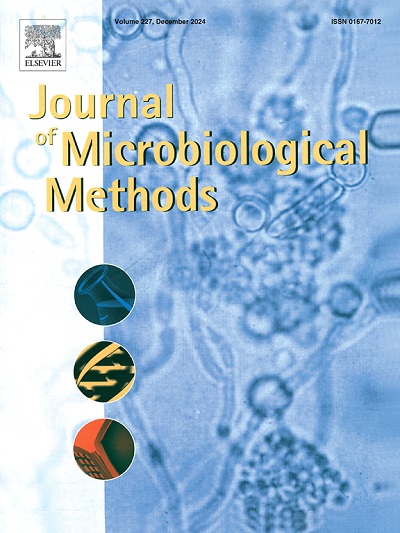Evaluation of saliva collected by the Self-Lollisponge® device for diagnosis of malaria in children
IF 1.9
4区 生物学
Q4 BIOCHEMICAL RESEARCH METHODS
引用次数: 0
Abstract
The Self-Lollisponge® device was used to collect saliva in children with malaria. Malaria antigens, namely, P. falciparum histidine-rich proteins 2 (PfHRP2) and Plasmodium lactate dehydrogenase (pLDH) were detected in blood and saliva samples. Subsequently, replicate samples with malaria antigens were stored at room temperature (28 °C) and 6 °C for 7 days. Malaria antigens were detected on days 1, 3, and 7. In the blood, PfHRP2 was detected in all 212 malaria samples, while pLDH was detected in 117 of the 212 samples (55.2 %). In the saliva, PfHRP2 was detected in 99/212 (46.7 %) samples while pLDH was detected in 111 of the 117 (94.8 %) samples whose corresponding blood had the pLDH detected. Compared to the blood samples, the overall sensitivity and accuracy of using saliva to detect PfHRP2 antigens were 46.7 % (95 % CI: 39.8–53.7 %) and 56.9 % (95 % CI: 50.6–63 %), respectively. Further, the overall sensitivity and accuracy for the detection of saliva-pLDH were 94.8 % (95 % CI: 89.2–98.1 %) and 96.4 % (95 % CI: 92.3–98.7 %), respectively. The PfHRP2 antigens were preserved for three days at 6 °C but at room temperature, the stability was for just a day. Nonetheless, the pLDH reduced comparatively faster, irrespective of the storage temperature.
self - lolisponge®设备收集的唾液对儿童疟疾诊断的评价
Self-Lollisponge®设备用于收集疟疾患儿的唾液。检测血液和唾液中疟原虫抗原,即恶性疟原虫富组氨酸蛋白2 (PfHRP2)和乳酸疟原虫脱氢酶(pLDH)。随后,将含有疟疾抗原的重复样品分别在室温(28°C)和6°C保存7天。在第1、3、7天检测疟疾抗原。212份疟疾血样中均检出PfHRP2, 117份血样中检出pLDH(55.2%)。唾液中PfHRP2的检出率为99/212 (46.7%),pLDH的检出率为111 / 117(94.8%)。与血液样本相比,使用唾液检测PfHRP2抗原的总体敏感性和准确性分别为46.7% (95% CI: 39.8 ~ 53.7%)和56.9% (95% CI: 50.6 ~ 63%)。此外,唾液- pldh检测的总体灵敏度和准确性分别为94.8% (95% CI: 89.2 - 98.1%)和96.4% (95% CI: 92.3 - 98.7%)。PfHRP2抗原在6℃下保存3天,室温下稳定性仅为1天。尽管如此,与存储温度无关,pLDH相对降低得更快。
本文章由计算机程序翻译,如有差异,请以英文原文为准。
求助全文
约1分钟内获得全文
求助全文
来源期刊

Journal of microbiological methods
生物-生化研究方法
CiteScore
4.30
自引率
4.50%
发文量
151
审稿时长
29 days
期刊介绍:
The Journal of Microbiological Methods publishes scholarly and original articles, notes and review articles. These articles must include novel and/or state-of-the-art methods, or significant improvements to existing methods. Novel and innovative applications of current methods that are validated and useful will also be published. JMM strives for scholarship, innovation and excellence. This demands scientific rigour, the best available methods and technologies, correctly replicated experiments/tests, the inclusion of proper controls, calibrations, and the correct statistical analysis. The presentation of the data must support the interpretation of the method/approach.
All aspects of microbiology are covered, except virology. These include agricultural microbiology, applied and environmental microbiology, bioassays, bioinformatics, biotechnology, biochemical microbiology, clinical microbiology, diagnostics, food monitoring and quality control microbiology, microbial genetics and genomics, geomicrobiology, microbiome methods regardless of habitat, high through-put sequencing methods and analysis, microbial pathogenesis and host responses, metabolomics, metagenomics, metaproteomics, microbial ecology and diversity, microbial physiology, microbial ultra-structure, microscopic and imaging methods, molecular microbiology, mycology, novel mathematical microbiology and modelling, parasitology, plant-microbe interactions, protein markers/profiles, proteomics, pyrosequencing, public health microbiology, radioisotopes applied to microbiology, robotics applied to microbiological methods,rumen microbiology, microbiological methods for space missions and extreme environments, sampling methods and samplers, soil and sediment microbiology, transcriptomics, veterinary microbiology, sero-diagnostics and typing/identification.
 求助内容:
求助内容: 应助结果提醒方式:
应助结果提醒方式:


